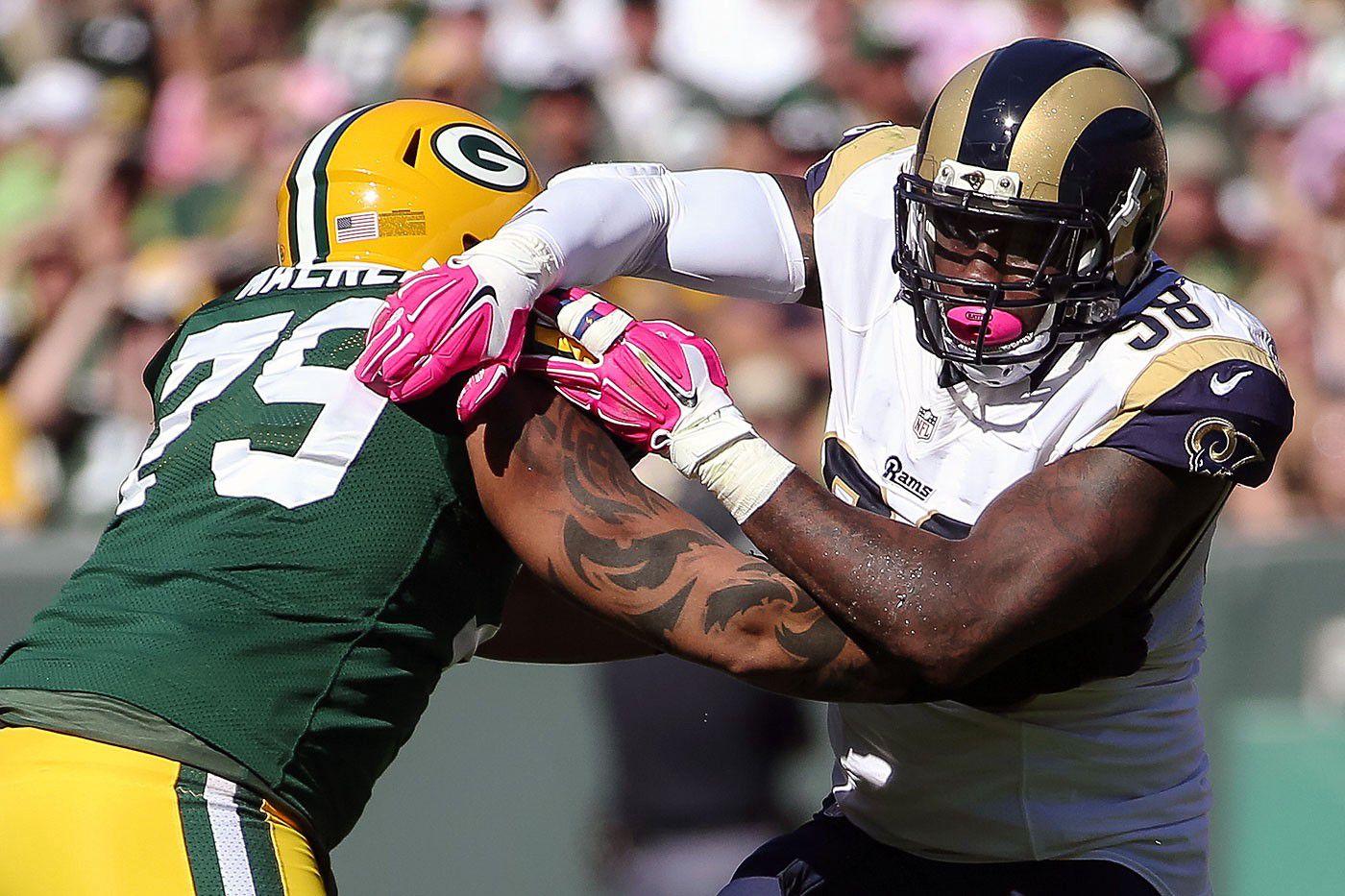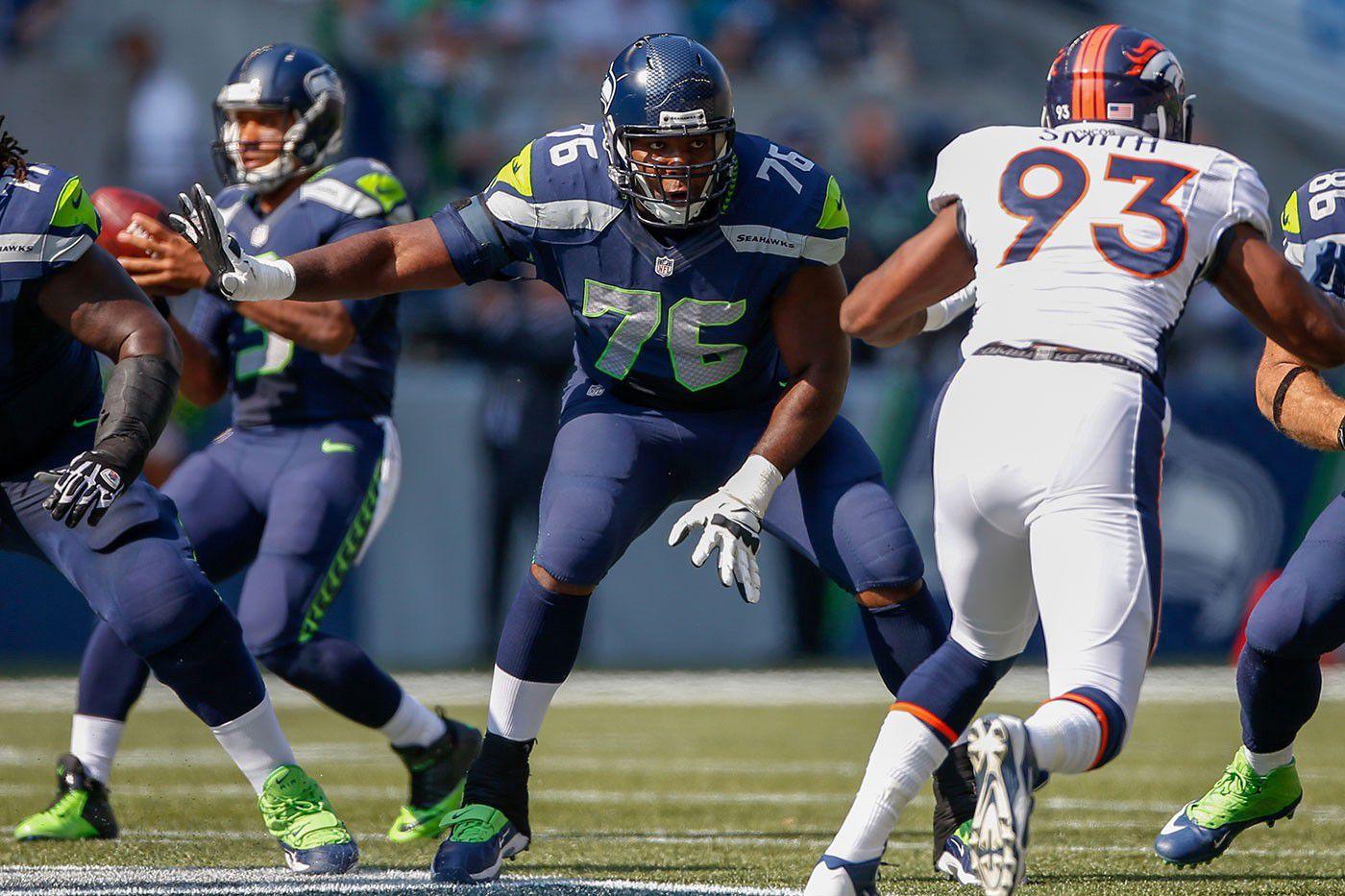The NFL offseason features a lot of moving parts: 32 rosters of 53 bodies, a seven-round draft, and a massive free-agent pool make for plenty of change before a given season kicks off. In an effort to get you ready for the 2016 campaign, The Ringer will spend each Friday through September 2 doing its part to remind you how the dust settled — who landed where, what will be expected of them, and what’s different than it was last year. Today, we’re looking at the bargain-priced veterans who were plucked from the clearance bin during free agency and could make significant impacts this fall.
Evan Mathis, G, Cardinals
Contract: one year, $4 million with $2 million in incentives
This offseason, the two-time Pro Bowler had surgery on his ankle, departed the Super Bowl champions to join a different contender, and switched positions (from left guard to right guard) — and it still must have seemed boring compared to what he experienced last year. The Evan Mathis saga was an ongoing story line last summer, as he was released by the Eagles in June when Philly wasn’t willing to give him a slight salary bump.
Fans of any team with line issues clamored for his signing in 2015; Mathis ultimately joined the Broncos last August. His time in Denver culminated with a Super Bowl ring, but last season proved bumpy overall. Hamstring and ankle injuries bothered Mathis throughout the year, hampering his ability to settle into the offense. By the playoffs, though, he was playing more or less like his old self, and the Cards inked him to a one-year deal in March. They’re hoping that the adjustment will be smoother this time around, given that he had an entire offseason to recover from a procedure to remove bone spurs from his ankle and become familiar with his new linemates.
Adding guard Mike Iupati (and handing the ball to dynamic rookie David Johnson) helped Arizona’s rushing offense jump from 30th in DVOA in 2014 to 16th in 2015, but right guard remained a trouble area for the Cardinals. Ted Larsen and Jonathan Cooper rotated at the position opposite Iupati last fall, and that football adage about quarterbacks — if you have two, you really have none — also rings true for positions along the offensive line. Mathis is a potential force in the running game, and his deal (worth up to $6 million with incentives) is a low-risk move for a team that is only concerned with winning a Super Bowl.
Nick Fairley, DT, Saints
Contract: one year, $3 million with $1.8 million in incentives
No one was more excited than I was last year after Fairley decided St. Louis was the best place to rebuild his value following an injury-riddled 2014 season. Aaron Donald, Robert Quinn, Chris Long, and Fairley. The forecast for opposing offenses was mostly pain with a slight chance of agony.

Credit to Bill Barnwell, who tried to warn me that Fairley wouldn’t get the chances he needed while buried behind Michael Brockers on the depth chart. He was right: Fairley played roughly one-third of the Rams’ defensive snaps, and finished last season with half a sack. On the Saints, he’ll have no such problem.
New Orleans ranked dead last in pressure rate in 2015, according to Football Outsiders, and even after the team took Louisville pass rusher Sheldon Rankins (whom I love) with the no. 12 pick in the 2016 draft, Fairley should have plenty more chances this time around. He’s still only 28 and has a lot left in the tank.
One quick note about Fairley’s deal, only because it’s the most #Saints thing ever: To fit Fairley under the cap this year, New Orleans organized his contract such that it’s technically a three-year deal, but years 2 and 3 void in February. That allowed the team to spread his signing bonus over three seasons, meaning Fairley counts just $1.5 million against the 2016 cap, but he’ll automatically count another $1.5 million against the 2017 cap even though he won’t be on the roster. The Saints are the best.
Matt Slauson, C, Chargers
Contract: two years, $3 million (only $600K guaranteed)
The highest compliment I can pay Slauson is that when Chicago cut him in early May, my response was, “Wait … what?” In three seasons with the Bears, Slauson served as a reliable, versatile piece who could play both guard spots and even spent a chunk of last year at center. When Chicago drafted Kansas State guard Cody Whitehair in the second round of this spring’s draft, I assumed that meant its plan along the offensive line would include some combination of Whitehair, Slauson, and either Ted Larsen or Manny Ramirez on the interior. Guess not! Cutting Slauson saved the Bears about $2.5 million in cap space, and even if that didn’t (and still doesn’t) feel worth it, Chicago’s loss becomes Philip Rivers’s gain.
Over the past few years, the only job more dangerous than playing drummer for Spinal Tap has been playing center for the Chargers. In 2014, San Diego used four different centers after longtime starter Nick Hardwick went down 15 plays into the season; the last of them, former undrafted free agent Trevor Robinson, was thrust into duty for most of 2015 after the team lost its starter of choice, Chris Watt, to a concussion and a shoulder injury.
Slauson has played 16 games in five of his six NFL seasons, and he should give the offensive line stability it’s sorely been lacking. Watching the first episode of The Night Of was less excruciating than watching San Diego’s 31st-ranked running game last year, and if Slauson and the rest of the unit can stay even a little healthier in 2016, second-year tailback Melvin Gordon shouldn’t look like he’s running into a brick wall on every play.
Karlos Dansby, LB, Bengals
Contract: one year, $2 million
Dansby is no stranger to this scenario: When the Dolphins cut the linebacker before the 2013 season with two years and $4.7 million in dead money left on his deal, Dansby signed a one-year, $2.3 million, prove-it contract with the Cardinals and parlayed a spectacular season into a long-term signing with the Browns. Cut this spring with two years and $3 million in dead money remaining on his deal, Dansby would love for his second prove-it campaign to go as well as his first.
Dansby will turn 35 in November and won’t get another contract within shouting distance of the one he got in Cleveland, but he could provide Cincinnati’s linebacking corps with a much-needed boost. Beyond Vontaze Burfict’s three-game suspension, the Bengals also must replace 910 combined snaps they got last year from A.J. Hawk and Emmanuel Lamur, neither of whom is still on the roster. Coverage always seems to be the area in which Cincy’s linebackers could improve, and with Dansby in the mix, they should.
Kelvin Beachum, T, Jaguars and Russell Okung, T, Broncos
Contract: one year, $5.4 million with a four-year, $40 option (Beachum); one year, $5.2 million with a four-year, $48 million option (Okung)
This entire situation is fascinating*. (*Shut up, yes it is.) Let’s parse it out.
To begin with, for two guys handed almost identical contracts, these two couldn’t have more disparate pedigrees. Seattle took Okung with the no. 6 overall pick in the 2010 draft; he went one spot behind Eric Berry and one spot in front of Joe Haden. Pittsburgh selected Beachum five spots before Mr. Irrelevant in 2012; he went one pick behind Alabama tight end Brad Smelley, who has perfectly adequate personal hygiene, I’m sure.

Okung emerged as the Seahawks’ starting left tackle four games into his rookie year, but injuries have plagued his entire career. He’s never started 16 games in a season, and after missing three more games last fall, health concerns followed him into free agency this spring. Okung negotiated his deal without an agent — the result is a structure that makes sense for a player with his history. After bonuses, he will get $5.2 million this year. If the Broncos pick up his option after the season, his $2 million base salary and $9.5 million roster bonus for 2017 and his $9.5 million salary for 2018 become fully guaranteed. So if Okung stays healthy and the Broncos keep him, he can cash in. If not, the champs paid less than market value for a starting left tackle this year.
Beachum’s situation with the Jaguars is similar but slightly different. He’s nearly two years younger than Okung, and his injury problems are limited to a torn ACL that cost him most of last season. But he also has a ton riding on his performance this fall: If he plays well and Jacksonville picks up his $5 million option, the franchise will have him through 2020 — his age-31 season — at an average of $9 million, the 13th-highest annual salary among current tackles. And almost none of it will be guaranteed.
Given the way Beachum played toward the end of his time with the Steelers, this has a chance to be an absolute steal for the Jaguars. The Luke Joeckel era at left tackle is already over in Jacksonville, with the former no. 2 overall pick playing left guard in training camp, but if Beachum can return to form, the team will have quarterback Blake Bortles’s blind side covered for a long time.
Prince Amukamara, CB, Jaguars
Contract: one year, $5.6 million
Other 2016 additions to the Jags’ secondary came with more fanfare (I mean, have you seen Jalen Ramsey?), but Amukamara could be a useful, inexpensive piece of a revitalized group. An injury-riddled stint with the Giants kept the former first-round pick from securing an attractive long-term offer this spring, but the 27-year-old should have a chance to rebuild his value in Jacksonville. It remains to be seen how the defense’s cornerback spots will shake out — Davon House is set to start on one side, and a House-Amukamara pairing with Ramsey in the slot makes sense — but teams need three starting corners nowadays. Amukamara should safely be in that group.
Terrance Knighton, DT, Patriots
Contract: one year, $1.8 million (only $250K guaranteed) with $300K in incentives
Bill Belichick has always shown an affinity for guys who have played well against him, and it’s been only two and a half years since Knighton snacked on the Patriots’ offensive line to the tune of four solo tackles, including a sack, during the 2013 AFC championship game. But worries about his weight limited Knighton’s opportunities in 2015 free agency, and it’s hard to consider his one season in Washington anything less than a disappointment. Still, at his best, Knighton has been a force against the run.
On New England’s end, a contract worth $1.8 million amounts to very little risk for a player who’s shown a ceiling like Knighton’s. Nose tackle Alan Branch is back for the Pats, but he’ll be 32 in December and had to start camp on the non-football injury list because of conditioning concerns. (He’s since been activated.) Like the rest of the moves on this list, New England’s decision to bring in Knighton just doesn’t come with much downside.